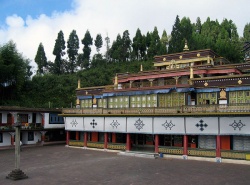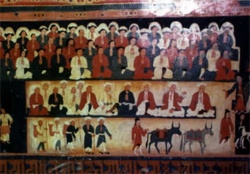Difference between revisions of "Buddhist Mercy for Tibetan Pheasants"
| Line 1: | Line 1: | ||
[[File:Rumtek monastery.jpg|thumb|250px|]] | [[File:Rumtek monastery.jpg|thumb|250px|]] | ||
<poem> | <poem> | ||
| + | |||
| + | |||
| + | |||
| + | |||
| + | |||
| + | |||
| + | |||
| + | |||
The [[Garze Tibetan Ethnic Group Autonomous Prefecture]] is located on the southern tip of the [[Qinghai]]-[[Tibet]] Plateau, [[east]] of the Henduan [[Mountains]], is a 7,323-square-km area full of thrilling scenery-none more so that the perennially snow-covered [[Buddhist]] {{Wiki|holy}} land called [[Nyainqengonggar Risumgongbu]]. | The [[Garze Tibetan Ethnic Group Autonomous Prefecture]] is located on the southern tip of the [[Qinghai]]-[[Tibet]] Plateau, [[east]] of the Henduan [[Mountains]], is a 7,323-square-km area full of thrilling scenery-none more so that the perennially snow-covered [[Buddhist]] {{Wiki|holy}} land called [[Nyainqengonggar Risumgongbu]]. | ||
| + | |||
About 8 km away from the county seat is the [[Zhiyi]] ([[Four-Dragon Monastery]] belonging to the [[White Sect]] of [[Tibetan Buddhism]]. | About 8 km away from the county seat is the [[Zhiyi]] ([[Four-Dragon Monastery]] belonging to the [[White Sect]] of [[Tibetan Buddhism]]. | ||
| + | |||
It was built in the middle part of the {{Wiki|Ming Dynasty}} (1368-1644), when [[Master]] [[Gamarpa Dorsumqenba]] gave lectures there on [[Buddhism]]. | It was built in the middle part of the {{Wiki|Ming Dynasty}} (1368-1644), when [[Master]] [[Gamarpa Dorsumqenba]] gave lectures there on [[Buddhism]]. | ||
| + | |||
It now has a [[Monk]] population of 118, who intermix the necessary [[duty]] of reciting [[Sutras]] with {{Wiki|farming}} and livestock breeding. [[Tibetan]] pheasants roam the courtyard. "We must show [[mercy]] to all [[forms]] of [[Life]]," say the [[Monks]]. | It now has a [[Monk]] population of 118, who intermix the necessary [[duty]] of reciting [[Sutras]] with {{Wiki|farming}} and livestock breeding. [[Tibetan]] pheasants roam the courtyard. "We must show [[mercy]] to all [[forms]] of [[Life]]," say the [[Monks]]. | ||
| Line 13: | Line 24: | ||
In this regard, they tell the following story: | In this regard, they tell the following story: | ||
[[File:Story 817d.jpg|thumb|250px|]] | [[File:Story 817d.jpg|thumb|250px|]] | ||
| + | |||
[[Senyi Qoigyai]], an {{Wiki|eminent}} [[Monk]] with the [[Monastery]], was [[meditating]] in the mountain one day. An injured [[Tibetan]] pheasant fell close by him, and the {{Wiki|eminent}} [[Monk]] brought it back to the [[Monastery]], where it recuperated. | [[Senyi Qoigyai]], an {{Wiki|eminent}} [[Monk]] with the [[Monastery]], was [[meditating]] in the mountain one day. An injured [[Tibetan]] pheasant fell close by him, and the {{Wiki|eminent}} [[Monk]] brought it back to the [[Monastery]], where it recuperated. | ||
| + | |||
The bird was set free when it had recovered. In October of the next year, however, a group of [[Tibetan]] pheasants turned up at the [[Monastery]] looking for [[Food]]. | The bird was set free when it had recovered. In October of the next year, however, a group of [[Tibetan]] pheasants turned up at the [[Monastery]] looking for [[Food]]. | ||
| + | |||
[[Seeing]] this, [[Monks]] brought out [[qingke]] {{Wiki|barley}} to entertain their feathered guests. Gradually, a [[Trust]] developed and the [[Tibetan]] pheasants stayed in the [[Monastery]] for seven months until the following May. In the late autumn, they returned with new group members. | [[Seeing]] this, [[Monks]] brought out [[qingke]] {{Wiki|barley}} to entertain their feathered guests. Gradually, a [[Trust]] developed and the [[Tibetan]] pheasants stayed in the [[Monastery]] for seven months until the following May. In the late autumn, they returned with new group members. | ||
| + | |||
| + | |||
The [[Monastery]] has now become a [[paradise]] for 2,000 [[Tibetan]] pheasants, as well as other birds, squirrels and hedgehogs. Each year, the [[Monastery]] allots 1,000 kg more of [[qingke]] for feeding purposes. | The [[Monastery]] has now become a [[paradise]] for 2,000 [[Tibetan]] pheasants, as well as other birds, squirrels and hedgehogs. Each year, the [[Monastery]] allots 1,000 kg more of [[qingke]] for feeding purposes. | ||
| + | |||
| + | |||
</poem> | </poem> | ||
{{R}} | {{R}} | ||
Latest revision as of 12:30, 11 December 2023
The Garze Tibetan Ethnic Group Autonomous Prefecture is located on the southern tip of the Qinghai-Tibet Plateau, east of the Henduan Mountains, is a 7,323-square-km area full of thrilling scenery-none more so that the perennially snow-covered Buddhist holy land called Nyainqengonggar Risumgongbu.
About 8 km away from the county seat is the Zhiyi (Four-Dragon Monastery belonging to the White Sect of Tibetan Buddhism.
It was built in the middle part of the Ming Dynasty (1368-1644), when Master Gamarpa Dorsumqenba gave lectures there on Buddhism.
It now has a Monk population of 118, who intermix the necessary duty of reciting Sutras with farming and livestock breeding. Tibetan pheasants roam the courtyard. "We must show mercy to all forms of Life," say the Monks.
"We do not allow anyone to commit killing in the Monastery. Thus, we have made friends even with these birds."
In this regard, they tell the following story:
Senyi Qoigyai, an eminent Monk with the Monastery, was meditating in the mountain one day. An injured Tibetan pheasant fell close by him, and the eminent Monk brought it back to the Monastery, where it recuperated.
The bird was set free when it had recovered. In October of the next year, however, a group of Tibetan pheasants turned up at the Monastery looking for Food.
Seeing this, Monks brought out qingke barley to entertain their feathered guests. Gradually, a Trust developed and the Tibetan pheasants stayed in the Monastery for seven months until the following May. In the late autumn, they returned with new group members.
The Monastery has now become a paradise for 2,000 Tibetan pheasants, as well as other birds, squirrels and hedgehogs. Each year, the Monastery allots 1,000 kg more of qingke for feeding purposes.

